Transportation network interruptions as an opportunity: Part 2
I was rushed writing yesterday's piece ("Transportation infrastructure interruptions as a missed opportunity for improving transportation demand management programming"), because I had a bunch of meetings, and so the piece as published wasn't as complete as I'd have liked.
I intended to augment the piece and republish it with today's date, but instead there are two follow up pieces. This one is more about some general planning points I failed to include. Tom Quinn's comments on the previous piece provides additional and specific solutions for Montgomery County-DC transportation network interruptions, which will be addressed in the third piece on specifics.
Corridor management as a strategy. The biggest omission was the failure to talk in general terms about the concept of "corridor management and planning," which is a big emphasis of the Federal Highway Administration. There's a lot of good work, published reports, etc., on the concept.
From the FHWA report, Integrated Corridor Management: Implementation Guide and Lessons Learned:
Integrated Corridor Management is the operational coordination of multiple transportation networks and cross network connections comprising a corridor and the institutional coordination of those agencies and entities responsible for corridor mobility. It will transform the manner in which transportation networks are managed within a corridor, enabling agencies to see the overall impact of multimodal transportation network management decisions and to optimize the movement of people and goods within the corridor instead of just on individual networks.
 The crisis generated by the rolling Metrorail closures is an opportunity for jurisdictions to apply corridor management approaches to more sections of the metropolitan area.
The crisis generated by the rolling Metrorail closures is an opportunity for jurisdictions to apply corridor management approaches to more sections of the metropolitan area. Virginia DOT (VDOT) has already adopted this approach to freeways as can be seen with the addition of HOT lanes as a capacity expansion and roadway management strategy for I-95/I-395 ("Virginia to extend I-95/395 HOT lanes north to D.C. line," Washington Post) and new plans and programs for I-66 ("Virginia launches its latest HOT lanes project "on I-66," Post), which they have branded the Transform 66 program with separate initiatives for "Outside the Beltway" and "Inside the Beltway."
The previous entry mentioned Virginia's desire to extend HOT lanes to Maryland in part to deal with future needed upgrades to the American Legion Memorial Bridge. We can criticize this proposal, but the integrated approach it represents is worthy of consideration.
I can't claim to be an expert on roadway planning in Maryland, and the State has announced an initiative for I-270, but I think it's fair to say that there isn't the same level of an integrated approach on the Maryland side. I-270 and I-495 as freeways need to be managed as an integrated system, but the I-270 and I-495 corridors need to be managed as part of the the broader transportation network, and corridor management planning needs to be based on transportation demand management principles and the incorporation of transit as part of the toolbox of solutions.
Roadway expansion often comes at the expense of investments in sustainable mobility. Like the tension in Northern Virginia between support of automobility versus sustainable mobility exemplified by Arlington's original opposition to HOT lanes ("Officials to consider road widening, HOT lanes through Arlington," Post) because rightly, such infrastructure promotes more single occupancy vehicle (SOV) trips, which are not prioritized in the County's Transportation Plan, this kind of transportation system management strategy has its downsides.
But since automobility isn't going away anytime soon, ignoring these issues doesn't help anyone either.
Ideally, a corridor management strategy focuses not just on expansion of capacity and management of the movement of motor vehicle traffic, it also focuses on transportation demand management and the complementary deployment of transit and other sustainable mobility initiatives as a capacity management program.
That's what needs to happen with I-270.
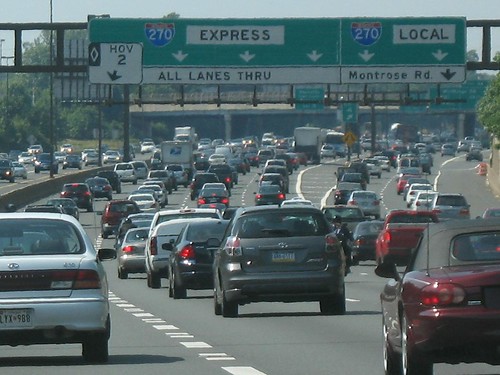
I-270, Wikipedia photo.
Inter-county traffic versus intra-county mobility priorities shape the agenda for County BRT. I think part of the issue with I-270 in terms of transit, at least for Montgomery County, is that because the road is a limited access freeway and under control of the State Highway Administration, it's not on their radar in terms of management because it doesn't have the same kind of impact on the county as do traffic-engorged arterials.
Note that as part of the FHWA development of corridor management planning approaches, I-270 was a test case, with a published report.
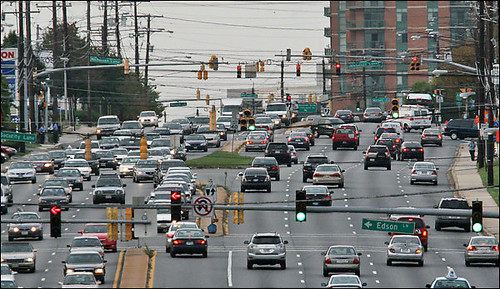
Rockville Pike is one of the corridors where Montgomery County proposes a robust BRT service. Washington Post photo by Bill O'Leary.
While the arterials that make up the bulk of a Maryland county's transportation network are mostly under state control also, because they are surface roads abutted by commercial and residential buildings, they have a much different impact on quality of life and the mobility system within the county, and that's why the County's BRT program is focused on improving transit and reducing automobile trips on these roads and not the freeways.
At the same time, it's not likely that in ordinary circumstances the SHA will be at the forefront of developing sustainable mobility approaches to I-270 improvements, so Montgomery County DOT needs to step in, and Frederick County needs to be in the mix as well.
Freeway-based bus service vs. arterial BRT. In the US, it's generally understood that freeway-focused bus rapid transit services haven't worked out very well in terms of ridership.
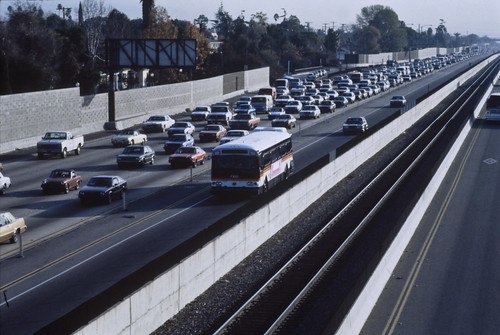
El Monte busway, Los Angeles County, the nation's first busway (but opened to HOV use three years later and to HOT use in 2013) opened in 1973. LA MTA photo.
In large part that's because freeway interchanges typically aren't population centers and make bad locations for gathering and concentrating bus riders.
Other places such as Curitiba, Brazil, Ottawa, Ontario, and various cities in Australia have created dedicated busway networks comparable to freeways, and those systems operate quite successfully.
But as nodes in a regional transit network, complemented by local service, perhaps in some areas, freeway-based bus transit services may deserve reconsideration.
Imagine the impact of freeway-based bus services if there were separated busways within freeway corridors, but in a manner separate from HOV and without fear of encroachment from motor vehicle traffic.
This slide from a TRB conference presentation "Integrating BRT & Freeway Operations: Experience & Lessons from Canada, New Zealand & Australia," showing the rendering for a separated busway in Brisbane, Australia illustrates the point.
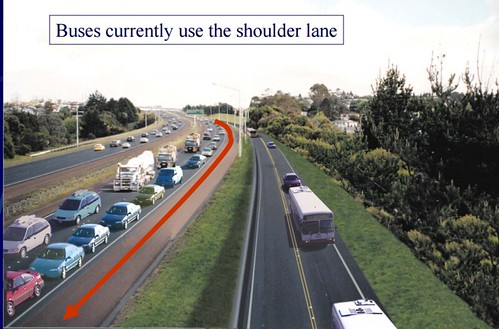 .
.The problem is that "highway agencies" tend to focus on freeways as infrastructure for cars and trucks, not transit, and don't conceive of freeways as one element, foundational to be sure, of a multi-modal transportation system providing service at multiple scales, and that the freeway element should be capable of and designed to serve transit, not just cars and trucks.
Minneapolis is working to put BRT service on I-35, calling the service the Orange Line. It already has an operating station at the 46th Street Bridge.
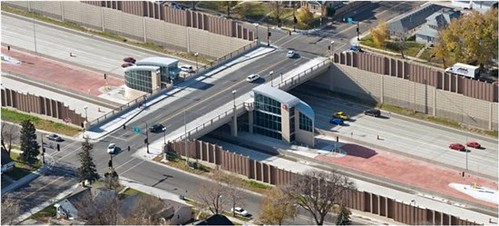
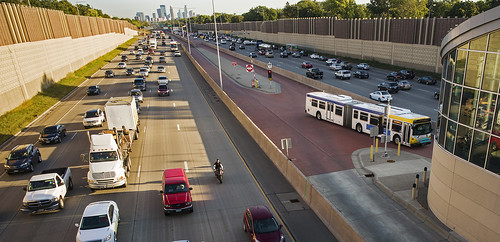
First photo, Metro Transit, Minneapolis. Second photo, "Metro Transit needs business community supporters to step up," Minneapolis Star Tribune.
In terms of traditional long distance commuter bus service, it's worth considering whether or not we've captured all the opportunities for such service within freeway sheds. That being said, Maryland has an extensive commuter bus program, as do farther out counties in Northern Virginia. Commuter Connections produces maps of Park and Ride locations too.
My sense is because of MARC and Metrorail service in the I-270 corridor, at least in its Frederick and Montgomery County sections, there might be fewer MTA Commuter Bus lines than there is the potential. Each commuter bus run is equal to 50 separate car trips.
Maybe there is more demand than we think, especially for west county destinations like Bethesda which aren't served now from the west. Similarly, Silver Spring isn't a destination for western commuter bus routes, although it is a destination for routes emanating from Howard County.
Adding microtransit to the service mix for "last mile" service. Primary transit services, like subway, railroad and commuter bus, are great for long distance travel and high capacity but in few instances take people to their final destination.
To facilitate efficient delivery of the passenger to their final destination, commuter bus stations on a freeway need to be complemented with local transit services. Traditionally this is done with regular bus line service.
But I don't think that's enough. Microtransit options including shared taxi services such as in "exurban" Montreal or vans and small buses such as done by Bridg or Chariot would be a good addition to the service mix, adding more support for what I call tertiary or intra-district transit needs.
These types of "flexible transit services" have been around for awhile (Operational Experiences with Flexible Transit Services, Transit Cooperative Research Program, 2004), but now rebranded "microtransit" since they've been enhanced with more flexible routing and scheduling capabilities enabled by IT and telecommunications (Shared Mobility: Definitions, Industry Developments, and Early Understanding, Berkeley Transportation Sustainability Research Center' New Mobility Discussion Paper, Metrolinx, Toronto).
Suburban intra-district transit service. The
Airport Corridor Transportation Association in the Robinson District of Allegheny County, outside Pittsburgh provides one example of how to do intra-district transit in suburban settings.
They are in the region's "airport district" but a lot of workers come from the City.
ACTA has created demand-response transit services, service hubs, and other programs to make it easier for people to get to and from work without driving.
(These are the kinds of districts where I think microtransit services should be targeted, although the services tend to be focused on denser urban markets already served by transit.)
Besides the RideACT microtransit service, they have also created a transit hub at a major shopping district, at a transit stop with both regional and local bus service ("Transit Super Stop planned for Robinson," Pittsburgh Post-Gazette).
From the article:
The Airport Corridor Transportation Association will hold a grand opening Tuesday of what it is calling the region's first Super Stop, a hub that will serve bus passengers, pedestrians and bicyclists, at the corridor's busiest bus stop in front of IKEA in Robinson.ACTA has also published some good work on suburban district transit planning:
The stop is the transfer point for RideACTA, the free on-demand service that enables riders of Port Authority's 28X Airport Flyer to connect to workplaces within a 1.5-mile radius. Two other authority bus routes also serve the stop. Lynn Manion, ACTA executive director, estimated that 400 riders use the stop on a typical day.
The stop will have two shelters with seating and standing room, and the back walls will have a plastic film with images of IKEA furnishings so that when riders sit on the benches, it will appear as though they are in a living room. The stop will have bike racks, picnic tables, benches, trash receptacles and a bike work station where cyclists can make simple repairs.
-- Rethinking the Suburban Bus Stop, ACTA
-- Moving Around Within A Suburban Commercial Area, ACTA (the concepts pertain to intra-district mobility more generally)
Labels: car culture and automobility, sustainable mobility platform, transit marketing, transportation demand management, transportation planning, transportation system management




8 Comments:
Off topic:
http://www.newyorker.com/magazine/2016/09/26/jane-jacobs-street-smarts
Great. Thank you.
some comments.
- regardless of Columbus Ave. in NYC, length of blocks still matter. In the L'Enfant plan some blocks are 2x or 3x the width of a normal block. At least on H Street and Pennsylvania Ave. SE, those are the blocks that are the hardest to make vibrant. (On PA Ave. it doesn't help that there is bad rebuild that further sucks energy from the street.)
- while yes, she was wrong that ag. productivity was birthed by cities, it was spurred by agglomeration, at least back a few thousand years.
- this point he makes, "Books written in a time of crisis can make bad blueprints for a time of plenty" is one that we talk about here, stated differently, that the systems we have are artifacts of their time, and don't necessarily work now.
The line I say from time to time is that "practitioners aren't very good at generating meta-theory." (Sadly, people tend to prefer to higher practitioners because of 'their experience' and dis the rare breed among us of 'meta-theorizers' who can likely do both. The other way to say this is Bismarck's quote "fools learn from their experience. I prefer to profit from the experience of others.")
There is no question that the basic urban design and density points JJ made are "universal" and at that time, and still today, relevant with the need for constant repetition and reinforcement.
But the way the real estate development and property ownership and management industry, financing, and the structure of various retail sectors is so much different now, that her prescriptions are less apt, and only work in the absolutely largest cities which have great density still and so many extant small footprint commercial spaces that are unappealing to the scales desired by a reorganized retail sector.
- yes, inability to keep building housing/to grow a city (by comparison Houston to any major center city with fixed borders) means that as demand increases, lower income households are priced out, unless there is provision for social housing and subsidy, probably on the Vienna scale. Or again, in the Vienna model, you take the ability to individually profit out of it, by making most of the housing market permanently rental.
Fortunately, there aren't that many cities where this is a crisis, but it is a problem in a select set of cities (Boston, NYC, DC, Seattle, SF, West Los Angeles/Los Angeles County) and there are no good solutions.
- the spread of incomes in the US was so different in 1960 than "in the last fifteen years," and that's a change she never anticipated. Nor the reorganization of retail, the rise of the digital economy, the changes in how people shop, discount pricing at stores (a phenomenon just starting when she wrote Death and Life) etc.
He attributes this to "the free market" of today, but I think it's more complicated. But also more complicated by the rise in upper household incomes.
- continued -
- continued -
According to Wikipedia, the first major Korvettes store was built in 1954. Kmart didn't start til 1962. Around the same time Korvette's opened its first suburban store, Herbert Haft challenged "manufacturers suggested retail price" and sold discounted items at his store in Adams Morgan.
- since the market doesn't produce what "we need" in city retail, I argue for extranormal participation of the state, through property acquisition and management initiatives like the Vital'Quartier program run by the SEMAEST community dev. corp. in Paris, or the now defunct retail promotion program, the "Historic Downtown LA Retail Project" which I wrote about in 2005 and later, but not recently. I have been meaning to write about it again, as a model for what cities need to do on an ongoing basis to seed and support retail.
- he says this better, "self-emerging systems are not self-governing systems. It takes intervention to sustain them."
- I guess the way to say this is she wrote about the structures of the time that produced housing and commercial activity that supported the middle class.
It wasn't so universal as she thought. And while the urban design recommendations were no less apt, the system that produced those conditions didn't generate the outcomes necessary to address low income needs and wants, public housing, etc.
It worked just fine though for the well off.
And also, it was totally irrelevant to integration and racial mixing. Economic equity was less of an issue because then, the middle class was probably pretty "equal" economically. Then most people didn't think about social equity.
========
your thoughts on the article?
Well, Gopnik is a terrific writer, and like all good writer hides as much as she shows. Framing it is Roosevelt Island vs the West Village is brilliant.
"Urban" thinking is one of those branches of practical philosophy that seems to always be currently fashionable, and you don't want to pick too much at this history. I'm not accusing you of that; if anything you are one of the few who thinks about the history.
But as I've said before, you can see on GGW that a good chunk of the population grew up playing SimCity and believes in that basically libertarian technocratic universe.
He is very explicit that city living is a luxury good, but he thinks it should be available for people with incomes, and not the super-rich (i.e. the problem of super gentrification).
Our technological overlords are very anti-city; goes back to Mumford. If we get their version (electric self driving cars that we telework from ) I suspect the Mumford version of a lot of smaller cities spread out will make more sense.
As I said his framing is brilliant; he really only glances on a issue that I harp on -- that cities are a giant set of self selecting practices and people.
1. I've never been to Roosevelt Island (other than going through it on the subway) but from everything I've read, people seem to like it just fine.
The thing is that buildings are envelopes, and as long as the urban design is right, things can work. And the density supports the "amenities package" that people want, etc.
It's true that only with multiunit housing can more people and more people of a variety of income levels be accommodated.
I suppose that level of population growth wasn't anticipated by JJ either.
2. with regard to "giant set of self selecting practices and people" Absolutely.
I used to argue that 14ish years ago. I'd say "f* the suburban people, we can't make ourselves over to appeal to them, even if we do they won't want to live here."
But yes, it's all about self-selection, a point I raise about why we want to build buildings with limited automobility privileging, in order to attract more people committed to sustainable mobility practice, to reduce demand for driving _in the city_.
3. Now more people (a la Leinberger) want to live in the city and because of our fixed stock of buildings etc., we are out of the range of affordability. The old affordability was produced by outmigration and the subsequent vacancy, and as I also write, advocates/groups developed an action paradigm focused on stabilization.
But now that the circumstances are different, stabilization isn't the issue, growth is possible, and in any case the city needs more revenue to do what we want it to do, and it needs more growth to be able to compete with the suburbs going forward.
People who came here in the times when demand was less than supply and therefore affordability obtained don't understand how the economics have changed, and now how restricting supply has major consequences.
Unlike the GGW types, I don't believe in demolishing blocks of SFH to build multiunit. But likely it will happen some, although probably towards the end of my lifetime.
But to accommodate my desire to not demolish blocks of housing, other accommodations need to be made including:
1. increasing the allowable height, in Downtown for sure, and maybe in certain other locations. (The thing about 'certain other locations' is that even if the enablement is present, developers and people will still prefer the downtown locations and it will be many many decades before there is demand for higher buildings in other places, the same dynamic of how development has taken decades to spread from Downtown, e.g., Brookland, RI Metro, etc.)
2. continued encouragement of infill housing development in commercial districts
3. density bonuses in transit sheds
4. disallowance as a matter of course of lopping off floors to appease residents, this comes back in reductions in housing supply and the city's revenue stream
5. strong encouragement to not have developers build smaller when they can build bigger and not impinge on the world
[check out the difference in height of the new infill housing on the 600 block of H St. NE between the extant office buildings which were constructed in 1989.]
6. encouragement of ADUs both separate and in-building (not either/or) including development of support and realization systems (subject of a future blog entry and what Edmonton does), including easing of tenant rights wrt "landlords" living in the main property.
7. building social housing in substantive ways, using Vienna and Singapore as models, and figuring out how to deal with the issue of socialization of the long term disaffected-disconnected.
about e-cars and the technologically enabled garden city utopia...
it's what I call, "Next generation asphalt nation." The primacy of personal-individual mobility.
By definition cars are about deconcentration and sprawl, cities are about intensification and sustainable mobility and "mass movement."
The stuff that Belmont writes about.
Unfortunately I don't have copies but Ford ran double-page ads on their 50th anniversary in magazines like Life and I remember seeing them, with the headline "The city will never be the same."
Cars are anti-city yes, and my joke about Detroit city is that it is the endgame for what automobile manufacturers wanted to have happen to cities.
again, that bikes vs. cars movie is decent, except for how it ignored the equal impact of the oil industry on the mobility paradigm.
Looks like I got the ad title wrong. It's "the street was never the same again."
http://blog.timesunion.com/rittner/files/2011/07/1953-Ford-magazine-ad-LG-Norman-Rockwell.jpg
just came across this TCRP report 145 on multimodal corridor management for interstates.
http://www.tcrponline.org/PDFDocuments/TCRP_RPT_145.pdf
Even for other roads, it's probably worth reading.
In Maryland in the I-270 corridor, Hogan wanted HOT lanes and they weren't approved.
So he announces that the state will have to cut back on other mobility priorities.
Maryland says it needs to cut transit, highway projects to offset lost private investment in toll lanes plan
https://www.washingtonpost.com/transportation/2021/06/22/maryland-highway-projects/
and there is a lack of consensus on what to do.
WTOP: Maryland, Montgomery County leaders lack consensus on how to ease I-270 congestion.
https://wtop.com/maryland/2021/06/maryland-montgomery-county-leaders-lack-consensus-on-how-to-ease-i-270-congestion/
There still wasn't really a good corridor management approach.
I've argued considering rail transit under the freeway should be considered. But the thing to do would be a massive collection of license plate data and figure out the origin and destination data (destination data would be almost impossible, but you could capture which direction at the Beltway and at city border entrances).
Post a Comment
<< Home